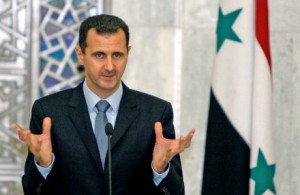London (AP) – Hopes that a US-led military strike on Syria may be avoided following Russia’s call for Damascus to put its chemical weapons under international control gave stocks a big lift Tuesday as well as pushing oil prices lower for the second day running.
Over the past couple of weeks, the steady drumbeat to war had spooked investors and weighed on a number of financial assets, such as stocks, but underpinned oil prices. Geopolitical worries, particularly when related to the oil-rich Middle East, are rarely conducive to risk-taking in the investing community. However, on Monday, it appeared that an imminent strike was unlikely especially after President Barack Obama said Russia’s proposal could potentially be “a significant breakthrough,” despite his skepticism that the Syrian government would follow through. A vote by the US Senate to authorize action, originally scheduled for Wednesday, has been postponed.
On Tuesday, hopes of a diplomatic breakthrough rose further after Russia’s Foreign Minister Sergey Lavrov said his country was working with Syria to prepare a detailed plan of action, which will be presented shortly.
“The reduced threat of military action appears to be reducing uncertainty and arguably may also lessen the risk that oil could push higher in the coming months,” said Jane Foley, an analyst at Rabobank International. “This all seems to be translating into a better outlook for global growth which is also supportive of risk appetite.” In Europe, the FTSE 100 index of leading British shares was up 0.8 percent at 6,582 while Germany’s DAX rose 1.6 percent to 8,408. The CAC-40 in France was 1.4 percent higher, too, at 4,095. Wall Street was poised for a solid opening too, with Dow futures up 0.4 percent and the broader S&P 500 futures 0.5 percent higher. Developments surrounding Syria will likely remain the main point of interest across financial markets through the day especially as the scheduled economic news out of Europe and the US remains light. As well as boosting stocks, the easing of tensions over Syria has helped push the price of benchmark New York crude down another 94 cents to $108.60 a barrel. Lower oil prices have the ability to shore up the global economic recovery.
Earlier, there was further evidence that China, the world’s number 2 economy, was over its recent soft patch, which had seen its economic growth moderate. Industrial production was 10.4 percent higher in August than the year before, ahead of the consensus of analysts’ forecasts of a 9.9 percent increase. “Activity data have surprised persistently to the upside over the last month and this should at least arrest the process of persistent forecast downgrades for a while,” said Adam Cole, an analyst at RBC Capital Markets. The figures helped further buoy stock markets, particularly in Asia. Tokyo’s Nikkei 225, the regional heavyweight, finished 1.5 percent up to 14,423.36. Hong Kong’s Hang Seng index was 1 percent higher to 22,976.65. China’s Shanghai Composite index gained 1.2 percent at 2,237.98. South Korea’s Kospi closed 1 percent higher to 1,994.06 and Australia’s S&P/ASX 200 advanced 0.4 percent to 5,201.20. The benchmark in the Philippines ended the day 1.6 percent up and Indonesia’s soared 4 percent at 4,358.14. India’s benchmark Sensex index also had one of the day’s highest gains, shooting up 3.8 percent to 19,997.10 as foreign investors went bargain-hunting to take advantage of the weakened rupee. Indian stocks were trading at their highest level since late July after the new Reserve Bank of India governor Raghuram Rajan outlined new confidence-boosting measures.
“There is a relief rally happening in the Indian markets,” said Jagannadham Thunuguntla, head of research for SMC Global Securities Ltd. in New Delhi. “But having said that, it may take considerable amount of time to call it a permanent turnaround.” Despite the euphoria evident in markets around the world Tuesday, risks remain. As well as monitoring developments over Syria, investors have a crucial meeting of the US Federal Reserve looming. The central bank is widely expected to announce plans to start phasing out its support program for the US economy following its meeting next week.
The dollar’s near-term fortunes will likely rest on the outcome of the meeting. On Tuesday, the euro was 0.1 percent down at $1.3241 while the dollar rose 0.5 percent to 100.15 yen.



